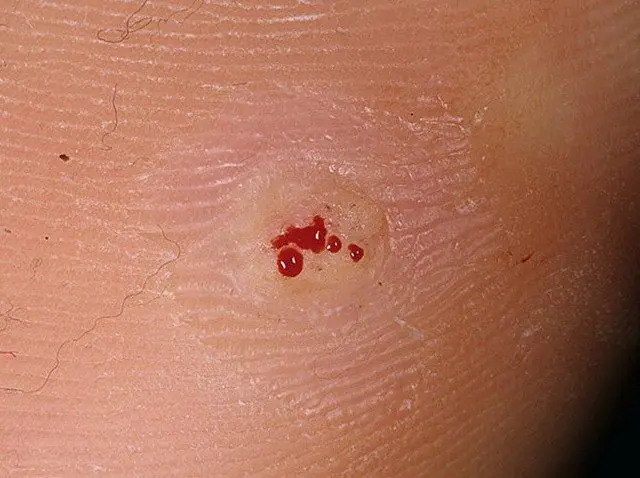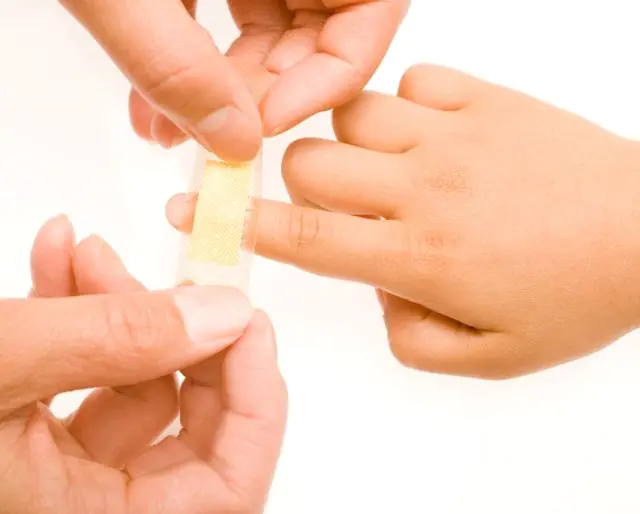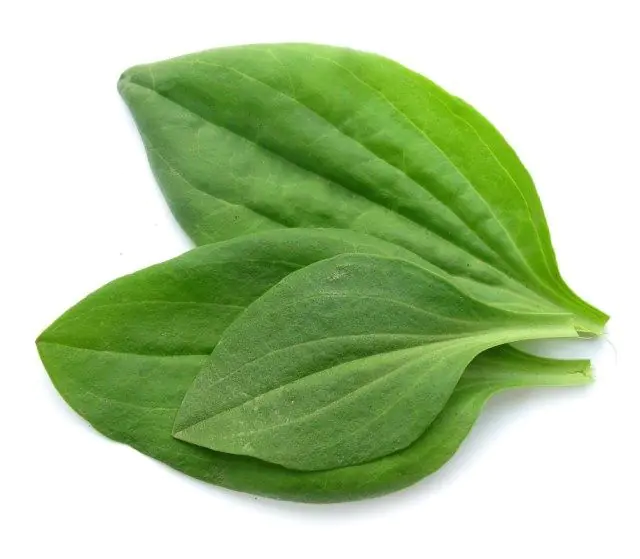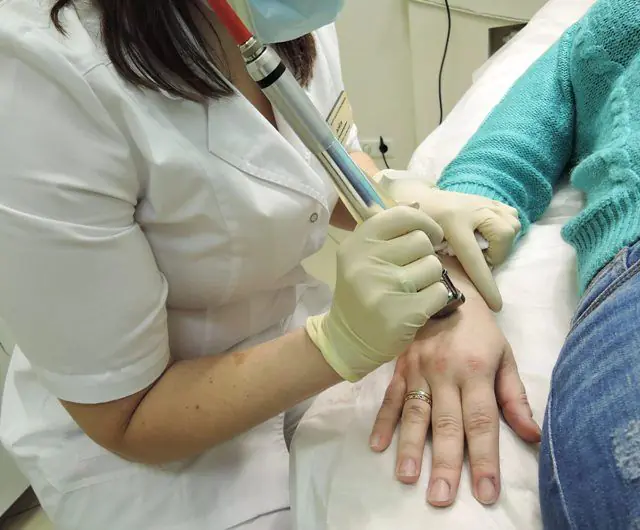
- Why does papilloma bleed?
- What to do
- First measures
- Medicines
- Folk remedies
- Physiotherapy if papilloma bleeds
Papilloma is a benign neoplasm that is a small lump on the skin that is pink, beige or brown. In its normal state, it has a dense crust and does not bleed, but this becomes possible when various abnormalities appear. This phenomenon is considered a pathology and requires timely decision-making. Let's find out what to do if the papilloma bleeds.
Why does papilloma bleed?

In the photo there are papillomas that bleed
Most often, this problem occurs in humans with hanging papillomas located on legs, but it can also occur in the case of flat formations.
The contributing factor to this is violation of their integrity. It can be mechanical and chemical. In the first case, damage to the growths occurs due to their constant contact with clothing and accidental injury due to this. Therefore, the papilloma begins to bleed.
If it is located under the armpit or in the genital area, then a violation of its integrity may be associated with sloppy shaving with a razor.
On the head, it often begins to bleed due to rough trimming, excessive use of scissors, combs, and the use of special devices for shaving hair.
Bleeding from papilloma can occur in those people who trying to remove it yourself at home using forceps and other devices in an aggressive manner. The problem arises due to the fact that this is done abruptly, roughly, without preliminary preparation - steaming and drying.
Sometimes the papilloma bleeds due to the negative effects of ultraviolet rays, as a result of the use of low-quality, synthetic care products and due to careless use of a washcloth.
Note! Why papilloma bleeds can be explained by decreased immunity, a lack of vitamins, and even low hemoglobin.- Read about Solcoseryl ointment for treating skin after papilloma removal
What to do if papilloma bleeds?
If blood appears from the formation, you should consult a doctor for advice. This needs to be done even faster if the papilloma not only bleeds, but has also become deformed, grown in size and causes pain. Until this moment, urgent measures must be taken to stop the bleeding, treat the wound with antiseptics to avoid infection and close it for the same purpose. Under no circumstances should you comb or remove growths yourself without a doctor’s permission.
First measures if papilloma bleeds

The photo shows how to provide first aid if a papilloma is bleeding
If blood comes from the papilloma, you should first, as with a normal injury, disinfect the problem area. To do this you can use any antisepticwhich will help stop the spread of the virus. First of all, you can wipe the formation with ethyl alcohol (price - about 30 rubles), but if the wound is open, the skin may sting a little. You can replace it with Chlorhexidine (10 rubles), Miramistin (220 rubles) or Betadine (price - 900 rubles).
After disinfection of the wound, it is recommended lubricate the growth with a solution of brilliant green (price - 50 rubles), which has hemostatic, regenerating, anti-inflammatory and drying properties. On top of it, after drying, you should put a small double piece of bandage or a sterile cotton pad, securing it with a band-aid (150 rubles).
If a papilloma bleeds, you should not apply the patch directly to the growth; later, when removing it, the formation may be accidentally removed, which can cause pain, increase bleeding, and leave a scar.
You need to change the bandage 2-3 times a day to protect yourself from infection of the wound.What medications should I use when there is bleeding from the papilloma?

The photo shows medications for the treatment of papilloma if it bleeds
If you do not know what to do when a papilloma bleeds, then before taking any medications, a dermatologist should examine the formation for suspicious defects. This is necessary to exclude the malignancy of the growth; a general blood and urine test and a polymerase chain reaction blood test will help refute this. These studies make it possible to detect the causative agent of papillomatosis and determine the type of HPV.
The following groups of drugs may be prescribed for treatment:
- Hemostatic. If a lot of blood comes from the papilloma, then you can drink a liquid extract of water pepper (price - 15 rubles). Among the tablets, Vikasol (25 rubles) or its analog Dicynon (350 rubles) deserve special attention. All this is taken in a course, on average for 1-2 weeks.
- Regenerating. Of the drugs for oral administration, Methyluracil (price - 40 rubles) is good, which has no analogues. In addition to it, you can use an ointment for external treatment of bleeding papillomas with the same name (cost: 100 rubles). It should be applied to the damaged formation 2-3 times a day until it is absorbed and the wound heals. An alternative to this option would be Levomekol (100 rubles) and Solcoseryl (360 rubles).
- Anti-inflammatory. These funds are needed to prevent swelling that may appear after blood begins to flow from the papilloma. An effective remedy is balsamic liniment (according to Vishnevsky, price - 20 rubles), which also accelerates the regeneration of tissues and formation itself, relieves pain and stops bleeding. Its popular analogues are Levosin (price - 80 rubles) and Zinc ointment (cost - 19 rubles). Thanks to all this, the skin will not become inflamed.
- Painkillers. If the bleeding of papilloma is caused by its close contact with clothing, then painful sensations are unlikely to be avoided. They can be eliminated with traditional tablets - Analgin, Ibuprofen, No-Shpa. They have options for replacement - Ketanov and Aspirin. The price of Analgin is 30 rubles (15 hryvnia). Among external remedies, doctors often prescribe Panthenol cream (63 rubles) and Eplan solution (100 rubles) to their patients. Children can use the “Heal-ka” cream (price - 76 rubles)
- Read about the beneficial properties of iodine in cauterizing papillomas
What folk remedies should I use if papilloma bleeds?

It is useful to use folk remedies in addition to drug therapy for injured papilloma. This increases the chances of a speedy recovery. For treatment, various herbs are needed, which can be purchased in dried form in pharmacies or from herbalists in the market. They cannot destroy the papilloma virus, but are effective in combating its consequences.
Here's what exactly can be used if the papilloma bleeds:
- Plantain. You will need one large leaf of this plant, rinse it with warm water, dry it, press it with your hands to release the juice and apply it to the bleeding papilloma for 10-15 minutes. If necessary, you can secure it on top with a bandage and plaster. Carry out treatment for 7-10 days. Plantain has antiseptic, hemostatic and anti-inflammatory properties. For it to help, the leaf must be fresh, just picked.
- Bread. The flour product must be black or rye. Remove the crust, crumble the pulp to small crumbs, fill everything with water. You need so much of it that it is completely covered with liquid. Let it absorb as much moisture as possible, drain off the remaining water and crush the crumb with your hands. Then place the prepared pulp on the formation and the skin around it, hold for about 10 minutes, remove and wipe with a clean, dry towel. This treatment method may take more than a week.
- Honey and celandine. If the papilloma is bleeding, squeeze the juice from the leaves of this plant and combine it (100 ml) with a bee product in liquid, warm form (2 tsp). Then stir the mixture well and apply it to the formation with clean fingers. After 10 minutes, carefully remove any remaining product and wipe the skin. The optimal duration of treatment is 2 weeks.
- Tea tree oil. It should be used only after the injured papilloma has been treated with an antiseptic and a small crust has formed. This product should be lubricated with growths up to 3 times a day using a cotton pad or swab. Treatment should be continued until the person's wound has healed.
- Banana peel. If there is bleeding from the papilloma, you should carefully remove the peel from the banana pulp, wipe with a damp sponge, and dry in the oven. This remedy must be applied to the formation 2-3 times a day for 5-10 minutes for a week. It will help stop bleeding, prevent the skin from becoming inflamed and accelerate tissue regeneration.
- Aloe. Its young leaves, plucked from the very bottom of the plant, should be applied to the formation for 10 minutes and kept under a bandage. It is necessary to carry out 2-3 such procedures per day; they help speed up wound healing, eliminate swelling and discomfort. Subsequently, they can be used to remove the growth that has already stopped bleeding. You can also squeeze juice out of aloe and wipe the problematic papilloma with it 5 times a day.
- Read about aloe juice for papillomas: contraindications and how to use
Physiotherapy if papilloma bleeds

The photo shows the removal of an injured papilloma
After eliminating the bleeding, if the integrity of the papilloma is broken and it does not recover for a long time, the doctor may recommend removing it through physiotherapeutic procedures. This should not be done if the skin is inflamed, red, or irritated.
Here's what you can do when a papilloma bleeds:
- Cryodestruction. This is an effective minimally invasive method of freezing and cauterizing the growth with liquid nitrogen, after some time it disappears on its own. This occurs due to the fact that its effect leads to the destruction of tissue cells and thus destroys the structure of neoplasms. One session lasts from 20 to 30 minutes. Anesthesia is usually not required. The price of cryodestruction is 360 rubles (from 150 hryvnia).
- Electrocoagulation. It is a safe, painless way to remove papilloma using high frequency current. This becomes possible due to an increase in tissue temperature and destruction of the formation. The device leaves a dry crust on the body, which after some time comes away from the skin on its own. This procedure lasts no more than 30 minutes and allows you to deal with the growth in one go. The price of electrocoagulation is 590 rubles (250 hryvnia).
- Laser therapy. To eliminate papilloma after it has stopped bleeding, a model of the device with a CO2 laser is most often used. Due to the high temperature, damaged cells are burned out, while healthy ones are not affected, this leads to self-removal of the growth. There is no bleeding during the procedure and no traces remain after it; only in rare cases a small scar may appear due to the inexperience of the doctor. One session lasts about 30 minutes and requires local anesthesia. The price of laser therapy is 2900 rubles (from 1300 hryvnia).
- Using a radio knife. This method is best suited for removing small papillomas. It allows you to avoid touching healthy tissues during surgery and cuts out only the tumor, which is done in a safe, non-contact way. To do this, the doctor directs an intense stream of radiation at the growth. The price of radiosurgical removal is 3000 rubles (from 1200 hryvnia).
Watch the video on what to do if papilloma bleeds:
You don’t always immediately understand what to do when a papilloma starts to bleed. The main thing here is not to get confused, immediately consult a doctor and approach solving the problem seriously. An integrated approach is required here: both external agents and oral medications should be used. Therapy should be carried out under the supervision of specialists and adjusted in time if necessary.
- Related article: benefits of vinegar in the treatment of papillomas



